Abstract
With the continuous advancement of optical fiber micromachining technology, C-type optical fibers have demonstrated significant potential in the field of optical fiber sensing. By partially or completely removing specific regions of the cladding, a “leakage window” is created, enabling interaction between the optical field and external substances. This structure has facilitated the development of various sensors. This paper reviews recent progress in the research and applications of C-type optical fibers in optical sensing. Based on sensing principles and application scenarios, C-type optical fiber sensors can be categorized into two main types: interferometric and photonic crystal types. This article discusses the fundamental operating principles and structural characteristics of each type, and provides a detailed comparison of their respective advantages and disadvantages. Studies have shown that sensors based on C-type fiber structures offer notable benefits such as simple fabrication, excellent mechanical performance, strong anti-interference capability, and high sensitivity. Therefore, they hold great promise for applications in intelligent monitoring, environmental detection, and healthcare. Finally, this review outlines future research directions for C-type fiber sensors. As technology continues to evolve, future studies are expected to focus on improving sensor stability, expanding application scenarios, and addressing challenges in current fabrication techniques.
1. Introduction
With the continuous advancement of optical fiber communication technology, fiber optic sensing has emerged and gradually become an integral part of modern sensor systems. Fiber optic sensors utilize optical fibers as sensing elements, leveraging the transmission characteristics of light signals to measure and analyze parameters such as temperature, humidity, and pressure. Due to their high sensitivity, strong anti-interference capability, and suitability for remote monitoring, fiber optic sensing technologies have been widely applied in aerospace [1], biomedicine [2], and environmental monitoring [3]. As the demand for advanced sensing grows, research in fiber optic sensors has increasingly focused on enhancing sensitivity and reliability. In such sensors, changes in the physical properties of the sensed medium can induce predictable alterations in the optical transmission characteristics of the fiber. Therefore, achieving effective interaction between the external environment and the evanescent field is critical to improving sensitivity [4,5]. Although conventional exposed-core fibers have achieved certain progress in enhancing sensitivity, their limited evanescent field area and interaction length constrain further improvement. Sensitivity can be enhanced by designing multiple polished regions; however, this approach may compromise the mechanical stability of the sensor, thereby affecting its long-term reliability [6].
Sahar Hosseinzadeh Kassani et al. [7] conducted early research on C-type optical fiber structures, proposing their use as the input and output sections of sensing units, spliced with Photonic Crystal Fibers (PCFs), to address issues in conventional PCFs such as small pore sizes, restricted gas flow, and complex fabrication processes. Their study further compared the performance of different PCF types in gas sensing through both experimental and numerical methods [8]. The results showed that C-type fibers significantly improved gas ingress efficiency, with the sensor sensitivity reaching 5.4 times that of traditional PCFs, and the response time under high gas concentrations exceeding that of conventional sensors by more than eightfold. This preliminary research laid a theoretical foundation for the fabrication and integration of C-type fiber sensors in optical fiber sensing systems. Rex Xiao Tan et al. [9] inscribed fiber Bragg gratings (FBGs) into C-type optical fibers, demonstrating the potential of this structure to mitigate temperature cross-sensitivity. Experimental results revealed that the C-type configuration could induce a stable polarization birefringence response in media with varying refractive indices, enabling high measurement stability without the need for additional temperature compensation mechanisms. This temperature suppression capability originates from the decoupling of the thermo-stress coupling path, which is inherent in the asymmetrical slot design, thereby reducing the influence of thermal drift on sensing signals. Razali et al. [10] employed the COMSOL Multiphysics 5.4 wave optics module to model the C-type fiber structure and compared its evanescent field distribution and sensitivity response with those of D-type structures and conventional single-mode fibers (SMFs). Simulation results indicated that within the typical liquid refractive index range (RI) (1.30–1.40), the effective RI sensitivity of the C-type fiber reached 0.966348101, slightly higher than that of the D-type fiber (0.966334412). Moreover, the C-type cross-section exhibited a more concentrated electric field enhancement region, suggesting superior light–matter coupling efficiency and sensing resolution. Further studies have proposed [11] that by adjusting geometric parameters—such as reducing the residual cladding thickness and increasing the slot angle—the electric field leakage ratio and sensing sensitivity of the C-type fiber could be significantly improved, while maintaining balanced cross-sectional stress and avoiding stress concentration. This structural optimization strategy highlights the advantages of C-type fibers in terms of geometric tunability and functional programmability, making them suitable for multiparameter coupling scenarios such as temperature–RI co-sensing and biofluidic thermodynamic disturbance monitoring. The excellent performance of C-type fibers not only enables their use as microfluidic channels in gas sensors but also opens new research directions for the design of other types of sensors. For example, in 2021, Zi-Ting Lin et al. [12] proposed a vector magnetic field sensor based on a C-type optical fiber. By leveraging the interference effects within the fiber and employing an asymmetrical structural design, the sensor enables vector magnetic field measurement through variations in optical path phase difference. These research outcomes have laid a solid foundation for the further development of C-type fiber sensors; however, challenges remain in terms of structural stability, fabrication processes, and environmental adaptability. This paper presents a comprehensive review of recent advances in C-type optical fiber sensors, with a particular focus on structural optimization, the application of novel materials, and breakthroughs in multiphysics coupling techniques. Furthermore, the potential of C-type fibers for simultaneous multi-parameter sensing is thoroughly examined, highlighting the significant role this research direction may play in the future development of fiber optic sensor technologies. In contrast to the existing literature, this work not only summarizes the advantages and limitations of current approaches but also introduces new research perspectives aimed at overcoming practical constraints in real-world applications. By analyzing the current technological bottlenecks, this paper provides both theoretical insights and practical recommendations for deploying C-type fiber sensors in industrial and environmental monitoring scenarios, offering new possibilities for their integration into next-generation intelligent sensing systems.
The structure of this paper is organized as follows. Section 1 provides an introduction to the typical applications and recent research progress of C-type optical fiber sensors, including a performance comparison with D-type fibers. Section 2 explores the structural design principles and operating mechanisms of C-type optical fibers in detail. Section 3 focuses on the representative configurations and application examples of interferometric sensors based on C-type fibers. Section 4 analyzes the structural optimization and performance comparison of C-type fibers, utilizing the surface plasmon resonance (SPR) principle. Finally, Section 5 summarizes the key challenges in the practical application of C-type fiber sensors and proposes research directions aimed at structural optimization, as well as improvements in stability and sensitivity. The paper concludes with a discussion on the broad application potential of C-type fibers in multiphysics integration and high-sensitivity detection.
2. Structural Design of C-Type Optical Fibers
2.1. Structural Design and Fabrication of C-Type Optical Fibers
The core sensing mechanism of the C-type optical fiber is based on mode regulation effects induced by its asymmetric cladding structure, specifically characterized by a strong evanescent field generated in the open region and geometry-induced birefringence. The structure under investigation is illustrated in Figure 1. Based on these features, the sensor design strategy focuses on two key aspects: first, optimizing the coupling efficiency between the evanescent field and the target analyte by precisely adjusting geometric parameters such as the residual cladding thickness and slot angle, while maintaining mechanical integrity; and second, incorporating microstructural modification techniques to construct sensitive units capable of multiphysics field coupling. Taken together, these design principles highlight the critical role of rational structural optimization and precise micromachining techniques in achieving the optimal performance of C-type fiber sensors.
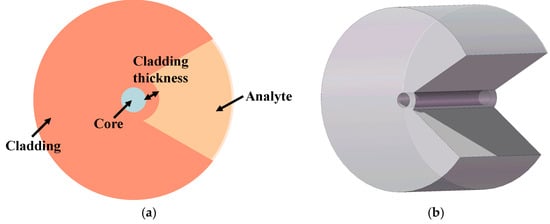
Figure 1.
(a) Cross-sectional view and (b) 3D structure diagram of the C-type optical fiber sensor.
The fabrication methods for C-type optical fiber sensors include chemical etching [13,14], mechanical polishing [15], and femtosecond laser direct writing [16]. However, during the chemical etching process, the concentration of the etchant and the etching time must be strictly controlled; excessive etching may lead to core damage, and the disposal of chemical waste increases environmental costs. The mechanical polishing technique removes cladding material layer by layer. Although this method can achieve submicron-level surface roughness, the induced stress concentration increases the risk of fiber breakage. In addition, axial asymmetry may lead to fluctuations in mode coupling efficiency. Although femtosecond laser micromachining has been widely employed for the precise fabrication of C-type fiber microstructures—owing to its ultrashort pulse duration, non-thermal damage, and high spatial resolution—it still faces two major technical challenges in practical engineering applications. First, it remains difficult to ensure sufficient machining precision. Parameters such as slot depth, slot width, opening angle, and axial symmetry are hard to maintain consistently, which adversely affects the structural uniformity and the reliability of the optical field distribution. Second, the fabrication process is prone to defects such as edge melting, microcracks, and expansion of the heat-affected zone, all of which can reduce the mechanical strength and optical performance of the sensor. Traditional single-pulse laser processing methods [17] often suffer from uneven energy deposition and focal point drift, resulting in poor morphological consistency and compromised machining quality. To address these challenges, various process optimization strategies have been proposed in recent years. Among them, the implementation of dual-pulse delay modulation has been shown to extend the effective interaction time window. When combined with a helical feed trajectory and a 3D pose control system, this approach improves path accuracy and structural stability [18]. In addition, the use of auxiliary gas flow and low-temperature platforms can facilitate rapid heat dissipation during processing, thereby reducing slag accumulation and stress concentration while improving the edge quality of microstructures. Moreover, closed-loop control platforms integrated with machine vision feedback [19] have been realized in some machining systems. These platforms enable the real-time correction of focal drift and path deviations, and support post-processing inspection and correction using interference microscopy or confocal profilometry. These technological strategies have significantly improved the repeatability and defect suppression capability of femtosecond laser micromachining in C-type fiber fabrication, enhancing its stability and adaptability for practical engineering applications.
2.2. Working Principle of C-Type Fiber Sensors
The background material of the optical fiber is made of silica, and the RI of silica can be determined using the Sellmeier equation [20], which is given by Equation (1):
where λ is the wavelength of the incident light, and n is the RI of silica. The C-type fiber sensor operates on principles similar to those of the D-type fiber sensor. Changes in the sensor structure and the analyte medium alter the propagation speed of light within the sensor, thereby modifying its effective RI, neff [21]. Numerically, neff can be expressed as shown in Equation (2):
where c is the speed of light in a vacuum, and Vg is the group velocity of light propagating through the optical fiber.
Changes in the external environment can be detected by monitoring shifts in the optical wavelength. When incident light transitions from an optically denser medium with a higher RI (n1) to an optically rarer medium with a lower RI (n2), Snell’s law dictates [22] that (3)
where θ1 is the angle of incidence and θ2 is the angle of refraction. Under total internal reflection (TIR), the incident light undergoes complete reflection when the incidence angle is greater than or equal to the critical angle. However, not all the light is entirely reflected; some incident light penetrates the optically rarer medium as an evanescent wave and then returns to the optically denser medium after a certain depth. During this process, the energy decays exponentially with increasing distance. This electromagnetic wave is referred to as an evanescent wave [23]. When the evanescent wave propagates in the Z-direction, the penetration depth de into the optically rarer medium [24] is related to the incident angle and the critical angle for total internal reflection, as follows (4):
where de represents the penetration depth in the optically rarer medium, θ1 is the angle of incidence, and θc is the critical angle for total internal reflection. The sensor relies on the interaction of evanescent waves with the analyte. Changes in the RI affect the penetration depth, making the interaction of evanescent waves an effective method for detecting the RI of unknown analyte media.
3. Interferometric Optical Fiber Sensor Based on C-Type Structure
3.1. Interference Principle
The detection principle of the optical fiber interferometric sensor is based on the modulation of the optical path difference between two coherent beams, with the RI and propagation path controlled by external parameters. Changes in the external environment cause variations in the effective RI or geometrical deformation of the cavity, leading to a displacement of the interference fringes. Demodulating this displacement allows for the inversion of the parameters [25,26].
Traditional interferometers enhance sensitivity through multi-beam interference but rely on coatings or fusion to form closed cavities. External parameters can only couple to the optical field through limited channels, and the complex fabrication process and discrete optical components restrict their application in harsh environments. To address this issue, the C-type optical fiber interferometer removes the cladding to form a C-type open cavity, achieving three innovative breakthroughs: First, the open cavity exposes the core directly to the environment, and the evanescent field efficiently transfers RI changes to the interference optical path. Second, the core-cladding interface and open end act as a natural reflector, forming high-contrast interference fringes without needing coatings, simplifying the fabrication process, and enhancing stability. Finally, adjusting the angle and depth of the C-type cavity optimizes a balance between sensitivity and mechanical strength. Although improvements are still needed in temperature drift suppression and multi-parameter cross-sensitivity, the interferometer based on the C-type structure, through the collaborative optimization of functionalized sensitive layer modifications and multi-wavelength decoupling algorithms, holds promise for providing innovative solutions for industrial multi-parameter real-time monitoring and extreme environmental sensor networks [27,28,29].
3.2. Fabry–Perot Interferometer Based on C-Type Optical Fiber
In RI sensing based on the C-type Fabry–Perot interferometer (C-FPI), thermal–optic and expansion effects induced by temperature fluctuations are the primary sources of measurement errors. Aqueous solutions and most colloidal materials typically have high thermal–optic coefficients, meaning that temperature changes can significantly impact the RI sensitivity. The thermal–optic effects caused by temperature changes alter the optical path of the FPI cavity, leading to shifts in the measurement signal and affecting the sensor’s measurement accuracy [30]. To address this issue, researchers have systematically explored strategies such as structural design, material optimization, and signal demodulation [31,32,33].
Early studies used physical isolation methods to suppress temperature interference. Liushun Xie et al. [34] integrated multiple C-type FPIs in series to realize multi-sensor integration. Combining with a temperature-controlled water tank could keep phase fluctuations within the standard deviation range. Although this method achieves high-precision measurements, its dependence on temperature control equipment limits its application in industrial environments. Therefore, the design of inherently temperature-insensitive structures has become a new area of research. Chuang Wu et al. [35] developed a fully glass-based C-FPI structure, utilizing the low thermal expansion coefficient of quartz to reduce the temperature cross-sensitivity to 3.04 × 10−7 RIU/°C, improving it by two orders of magnitude compared to traditional polymer-encapsulated structures. In addition, the authors investigated the effect of C-type cavity length on sensor performance, as shown in Figure 2. The study demonstrated that C-type optical fibers exhibit superior performance at shorter cavity lengths compared to traditional optical fibers. The advantage of this method lies in its strong temperature independence, making it suitable for applications that do not require external temperature control and avoiding most measurement errors caused by temperature variations. However, in dynamic temperature environments, residual thermal stress may lead to cavity length drift. Active compensation strategies are employed to achieve real-time error correction through multi-parameter demodulation to address dynamic temperature interference. Xuegang Li et al. [36] constructed a real-time temperature feedback mechanism, as shown in Figure 3. This mechanism utilizes a C-type optical fiber microcavity as both a reaction vessel and a temperature sensor, using near-infrared lasers to heat polymerase chain reaction (PCR) samples and monitoring changes in the Fabry–Perot interference spectrum to obtain temperature data. To overcome signal crosstalk caused by the dual-function coupling of a single sensor, the team further proposed a dual C-FPI architecture [37]. The C-type optical fiber is the interference cavity, where one cavity is sensitive to external RI and temperature changes. At the same time, the other is only sensitive to temperature changes. Temperature compensation is performed using the transfer matrix method by measuring phase changes from both interferometers. This approach is suitable for environments with significant temperature variations and effectively suppresses the impact of dynamic temperature changes on measurement results. Although this solution requires complex algorithmic support, it provides a practical framework for highly robust RI detection in dynamically controlled temperature environments.
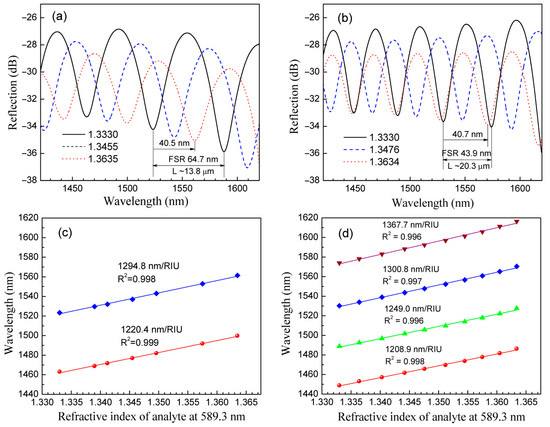
Figure 2.
Response to RI changes for different C-type cavity lengths: (a,b) show the response variations in the optical fiber at different environmental liquid refractive indices for L = 13.8 μm and 20.3 μm, respectively; (c,d) illustrate the linear relationship between liquid RI changes and the minimum interference wavelength for L = 13.8 μm and 20.3 μm, respectively [35].
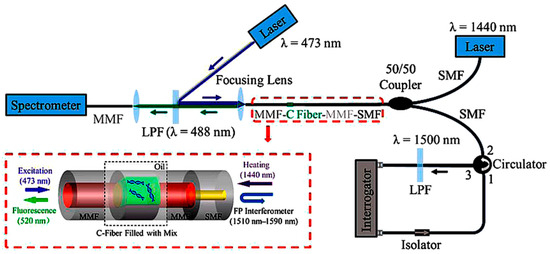
Figure 3.
Schematic diagram of the all-optical fiber qPCR system based on the C-type optical fiber microcavity [36].
In subsequent applications, researchers have successfully achieved dual-parameter decoupled measurements through functional material coatings and cavity partition designs to reduce the temperature cross-sensitivity of the C-type FPI sensor. The core of this approach lies in utilizing the selective response characteristics of temperature-sensitive materials to separate temperature interference signals from the target parameters, thereby improving measurement sensitivity. Fei Li et al. [38] demonstrated how optimizing the selection and filling of sensitive materials can significantly enhance the dual-parameter measurement capability of the sensor. Polyvinyl alcohol (PVA) was used to fill one section of the cavity to enhance its humidity sensitivity, while polydimethylsiloxane (PDMS) was used in another section to improve its temperature sensitivity. By constructing a sensitivity matrix to decouple the spectral shifts of the two cavities, this approach reduced the temperature cross-sensitivity error to the detection limit of 0.2% RH within the 20–45% RH range. However, PVA and PDMS’s moisture absorption and expansion properties may lead to coating delamination during long-term use, limiting their environmental stability. Building upon this, the KE ZHAO team [39] filled the C-type cavity with UV-curable adhesive (NOA61) as a temperature/humidity sensitive material, as shown in Figure 4. The results indicated that the high adhesion and rapid curing properties of NOA61 enabled humidity sensitivity of 0.248 nm/%RH within the 35–95% RH range, while temperature sensitivity reached −1.091 nm/°C. Compared to the dual-cavity design, this solution successfully shortened the response time while maintaining similar performance.
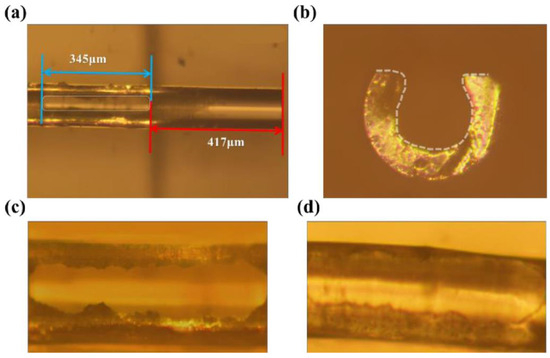
Figure 4.
(a) Schematic diagram of the cascaded structure of the FP interferometer; (b) cross-sectional view of the C-type cavity; (c) image of the C-type cavity before filling with NOA61; (d) image of the C-type cavity after filling and curing with NOA61 [39].
In summary, various temperature compensation techniques have played a key role in improving the performance of RI sensors. With the introduction of different approaches, the interference from temperature fluctuations on measurement results has been effectively suppressed. However, balancing system complexity and stability in practical applications remains a key challenge for future research.
Researchers have recently introduced the Vernier effect into these systems to improve the sensitivity of optical fiber interferometers further. This effect typically occurs in the superimposed spectra of two cascaded interferometers with slightly differing free spectral ranges, where one interferometer acts as the reference unit and the other as the sensing unit. When the two interference spectra are combined, the resulting composite spectrum exhibits a distinct “beat” characteristic: a periodic envelope. When the RI in the sensing unit changes, the spectral envelope shifts significantly, enhancing the interferometer’s sensitivity. Fei Li et al. [40] first applied this principle to C-type optical fiber structures, constructing a cascaded FPI by splicing single-mode fibers (SMF) with dual C-type cavities. With an RI range of 1.3311 to 1.3450, they achieved a high sensitivity of 10,791.12 nm/RIU, an 8.3-fold improvement over the traditional single FPI. To further enhance the gas response, HAIMING QIU et al. [41] proposed an open C-type sensing cavity design, allowing gases to directly interact with the microcavity’s RI modulation region, which increased the sensitivity to 37,238 nm/RIU. This design maintained a high sensitivity of 11,495 nm/RIU in liquid environments, demonstrating the synergistic effect of the cavity’s openness on the Vernier effect gain. In recent developments, Chaofan Li’s team [42] integrated salinity-sensitive polymers and thermal expansion units into the C-type cavity, enabling dual-parameter detection of salinity (−2.69 nm/‰) and temperature (−4.54 nm/°C). Figure 5 shows the dual C-type optical fiber Vernier gauge sensing structure fabricated using femtosecond laser etching. The sensitivity was improved by 11.58 times and 11.16 times compared to the single FPI, marking an important breakthrough from single gas detection to multi-parameter simultaneous analysis in complex environments.
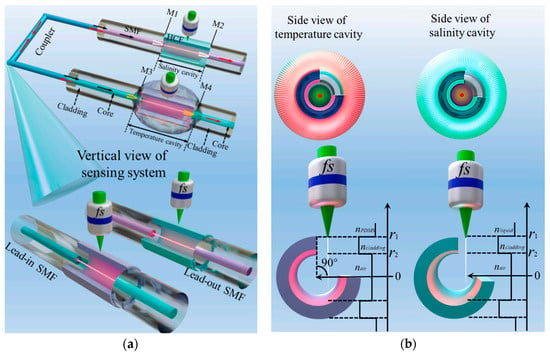
Figure 5.
(a) Schematic diagram of the dual C-type optical fiber sensing structure; (b) side view of the salinity cavity and temperature cavity [42].
Table 1 summarizes the key performance parameters of typical C-FPIs discussed in this section, highlighting the technological directions and structural optimization strategies for different microcavity structures in terms of sensitivity, detection range, and stability. By introducing UV-curable adhesives [39], PDMS [38], or filling liquids to construct multi-cavity coupled systems, excellent response consistency and environmental adaptability can be demonstrated in humidity, temperature, and dual-parameter fusion monitoring. Additionally, designs utilizing reflective surface modulation and microcavity scale control [34,35] have shown significant potential in improving sensitivity and processing repeatability. Overall, the C-FPI structure offers outstanding integration and miniaturization advantages, making it suitable for constructing high-stability sensing platforms for specific parameters. Future research breakthroughs should focus on (1) developing dynamic temperature control algorithms and embedded integration of miniaturized temperature control modules to address response lag in complex environments; (2) developing optical-sensitive composite materials with self-calibration functions for in situ parameter correction through the synergistic effect of photothermal interactions; (3) optimizing the Vernier effect optical path design to extend the detection dynamic range while maintaining high sensitivity. With the deep integration of micro-nano fabrication and intelligent demodulation technologies, C-FPI sensors are expected to achieve more precise environmental parameter analysis in fields such as biomedical real-time monitoring and industrial process online analysis.

Table 1.
Performance comparison of Fabry–Perot interferometers based on C-type optical fiber.
3.3. Sagnac Interferometer Based on C-Type Optical Fiber
Figure 6 shows the structural diagram of the Sagnac interferometer (SI). When the beam from a broadband light source enters the interferometer loop, it is split into two paths, one propagating clockwise and the other counterclockwise, at the coupling region. Due to the differences in the transmission optical paths of the two orthogonal polarization modes in the birefringent optical fiber, the two beams accumulate a net phase difference in the loop, which results in the Sagnac effect when they recombine at the coupling region. Compared to other types of interferometers, the SI offers advantages such as a simple structure and strong environmental robustness. However, because the SI requires a closed-loop structure, it usually results in a larger size. Despite these limitations, the SI still demonstrates extremely high sensitivity in sensing applications, particularly fluid RI measurements, with tremendous potential [43,44].
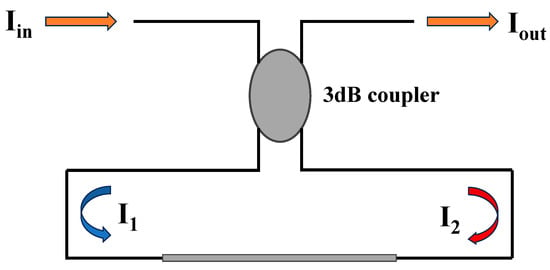
Figure 6.
Schematic diagram of a typical Sagnac interferometer structure.
In recent years, the introduction of C-type optical fibers has significantly improved the performance of SI in microfluidic sensing applications. Chuang Wu et al. [45] first proposed a composite structure based on C-type optical fibers connecting a photonic crystal fiber (PCF) and a single-mode fiber (SMF) (SMF-C-PM-PCF-C-SMF). The C-type optical fiber, with its open structure, provides a pathway for the liquid to enter the air holes of the PCF, solving the problems of liquid injection and flow control in traditional PCF sensors. Changes in the RI inside the PCF affect the propagation characteristics of light in the fiber, leading to changes in the phase difference of light in the SI. The results showed that the sensor achieved a sensitivity of 6621 nm/RIU in the RI range of 1.330 to 1.333. In subsequent research, the team [46] further optimized the fiber structure and the coupling method between the fiber and the fluid, selectively utilizing specific regions of the PCF through arc discharge technology, retaining only the larger central air holes to make the liquid flow more controllable. Compared to traditional PCF sensors, this selective use of air hole channels increased sensitivity by 70%. Xuegang Li et al. [47] utilized the C-type optical fiber’s non-circular symmetry and birefringent properties, as shown in Figure 7a, integrating it as part of the SI. The research showed that the sensor achieved a sensitivity of 2592 nm/RIU (see Figure 7b).
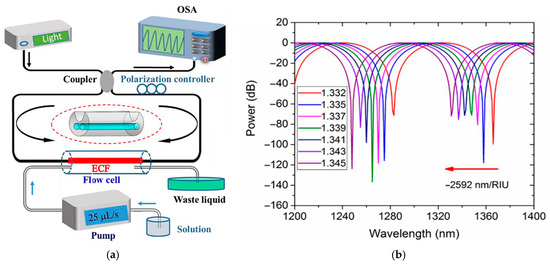
Figure 7.
(a) Schematic diagram of the sensing system. (b) Transmission spectra at different analyte refractive indices [47].
Table 2 summarizes and compares the key performance characteristics of C-type fiber-based Sagnac interferometers (SI). The proposed sensor demonstrates excellent performance in terms of sensitivity and stability. Compared to similar technologies, such as microfiber SIs, the C-type optical fiber significantly enhances the sensing sensitivity through structural optimization, such as an open cross-section and selectively retained air holes. Furthermore, this optimized design effectively overcomes the bottleneck of fluid injection difficulties and low light–matter interaction efficiency in traditional structures, providing an innovative solution for microfluidic detection and biosensing applications. Overall, the structural advantages of C-type optical fibers show great potential in efficient and precise sensing applications.

Table 2.
Performance comparison of Sagnac interferometers based on C-type optical fibers.
3.4. Mach–Zehnder Interferometer Based on C-Type Optical Fiber
The C-type Mach–Zehnder interferometer (C-MZI), due to its unique microstructure design and high sensitivity characteristics, has achieved a technological breakthrough in the field of optical fiber sensing, enabling the transition from single-parameter detection to multi-parameter synchronous monitoring. This section systematically reviews its technological evolution, reveals the performance optimization mechanisms, and discusses future development directions.
The C-type microstructured optical fiber, fabricated by Zi-ting Lin’s team [48] using an HF acid etching process, is shown in Figure 8a. It achieved a sensitivity of 3.25 nm/‰ in salinity sensing (range: 0‰ to 40.001‰). The core mechanism lies in the cladding mode refractive index change induced by the C-type groove. Through mode interference, the small RI changes caused by salinity are amplified into significant wavelength shifts (see Figure 8b,c). Qi Yu’s team [49] further expanded the application by combining a C-type electrochemical fiber (ECF) filled with magnetic fluid with an MZI. The magnetic fluid’s refractive index dependence on the magnetic field and the thermal expansion effect of the ECF enabled dual-parameter detection of the magnetic field (−0.18 nm/mT) and temperature (−0.16 nm/°C).
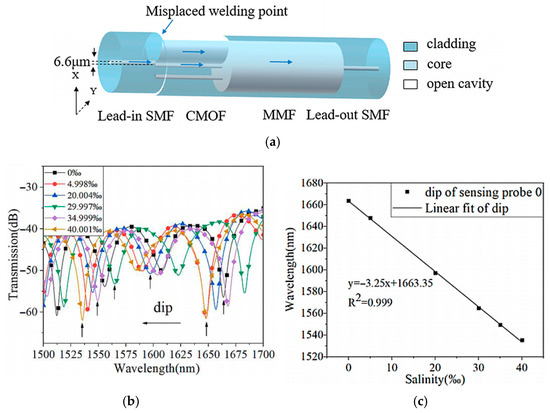
Figure 8.
(a) Sensing structure configuration. (b) Spectral response at different salinity levels. (c) Relationship between wavelength shift and salinity at various tilt angles [48].
To break through the detection limits of traditional MZIs, researchers have achieved a significant improvement in sensitivity through the Vernier effect amplification strategy and the design of novel interference structures. Yujian Li et al. [50] formed a dual-interferometer cavity by combining a single-core side-hole fiber (SCSHF) with a hollow-core fiber (HCF). In the pressure range of 0 to 100 kPa, the sensitivity reached 183 nm/MPa, demonstrating excellent repeatability and long-term stability. To further expand the measurement range and enhance performance stability during long-term use, Qian Wang et al. [51] designed an MZI salinity sensor based on a C-type dual-core eccentric-hole fiber (DCEHF). The dual-core eccentric-hole structure improved mode coupling efficiency, enabling wide-range detection from 0% to 36% salinity and achieving a sensitivity of −2.664 nm/‰ (equivalent to −15,100.67 nm/RIU). This performance improvement is attributed to the open-channel design of the C-type structure, which optimized fluid flow and increased response speed. However, while this design performs excellently in salinity detection, future research may need to optimize its stability and response time further for multi-parameter detection to achieve more precise environmental monitoring.
In the evolution of optical fiber sensing technology from single-parameter detection to multi-parameter synchronous monitoring, several composite sensing mechanisms have been proposed to achieve parameter decoupling, such as MZI, SI, MZI combined with FBG, and dual FBG sensors [52,53,54]. Xuegang Li et al. [55] addressed the long-standing issue of temperature cross-sensitivity by developing a composite sensing system combining FBG and MZI. This design integrates FBG and MZI interference structures within the same optical fiber, utilizing the high sensitivity of FBG to temperature (8.72 pm/°C) and the significant response of MZI to RI (794 nm/RIU), creating dual-mode sensing channels. By using NaCl solutions of different concentrations and adjusting the environmental RI and temperature with a water bath at different temperatures, FBG reflection spectra and MZI transmission spectra were recorded. The transfer matrix method was introduced, which solved the measurement problems of temperature and RI while effectively overcoming the temperature interference caused by the thermo-optic effect in water samples. To further enhance multi-parameter detection capabilities, the innovation of new interference structures has become a key breakthrough direction. The same author [56] introduced polarization-maintaining fiber in the SI-MZI composite system to construct a Sagnac ring, utilizing the birefringence-related phase shift (−0.0275 rad/°C) and the mode interference response of the MZI channel (−432 rad/RIU) to form a complementary detection mechanism. This dual-channel phase demodulation technique enabled the independent measurement of temperature and RI, achieving 2490 rad/RIU sensitivities and −0.0275 rad/°C, respectively. Jingxian Cui’s team [57] developed a multimode interference-enhanced sensor, as shown in Figure 9. Through structural innovation, the performance boundary was extended: the intermodal interference (IMI) structure, combining C-type and multimode fibers, achieved an ultra-high sensitivity of −7999.76 nm/RIU, while the core-intermodal interference (ICMI) structure using a three-core optical fiber, although with slightly reduced sensitivity (−6211.98 nm/RIU), improved measurement stability and enhanced the flexibility of multimode interference. These advances demonstrate that multi-parameter decoupling is shifting from simple device combinations to intrinsic structural designs, providing more adaptable solutions for complex environmental monitoring.
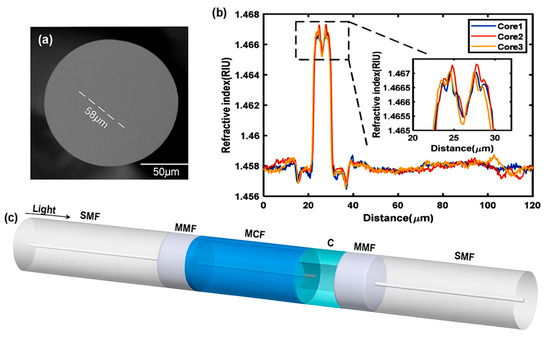
Figure 9.
(a) Microscopic image of a three-core optical fiber and (b) the measured relative RI distribution at a wavelength of 630 nm; (c) MZI configuration based on ICMI [57].
Table 3 summarizes and compares the key performance characteristics of C-MZI-based sensors. By comparing the studies in references [48,49], the design of the C-type optical fiber’s air cavity significantly enhances the interaction between the optical fiber and the measured fluid, especially in applications such as microfluidic sensing and gas detection. The C-type air cavity design increases the contact area between the fiber and the fluid, thereby improving the sensor’s sensitivity and providing a more efficient signal transmission mechanism, which helps to enhance detection accuracy in real-world environments. A further comparison of references [50,51] shows that the introduction of the Vernier effect significantly improves the sensitivity of C-type optical fiber MZI sensors. Enhancing the visibility of the spectrum and the signal-to-noise ratio provides more stable measurement results under low-signal and high-noise backgrounds. Comparing references [55,56,57], the combination of different interference structures, such as FBG with MZI, dual-core eccentric-hole fibers, and multimode fibers, both enhanced the sensor’s sensitivity and improved the independent measurement capabilities of physical parameters such as temperature and RI. Despite the significant performance improvements, balancing sensitivity, stability, and application range remains a key challenge. As the technology continues to develop, multi-parameter decoupling technology is advancing towards intrinsic structural designs, offering greater potential for optical fiber sensors in complex environmental monitoring applications.

Table 3.
Performance comparison of Mach–Zehnder interferometers based on C-type optical fibers.
4. C-Type PCF Based on SPR
With the increasing demand for more efficient and compact sensors, optical fiber sensors have become a focal point of innovative research in recent years due to their miniaturization features and advantages related to signal transmission [58]. Recent advancements in this technology have driven the need for smaller optical fiber devices in specific application environments. By studying different optical fiber structures, such as SMF, MMF, and HCF, many new optical fiber sensors have been developed [59,60]. However, despite the gradual maturation of multi-parameter detection technology, related devices still face challenges, such as limited structural activity and high processing difficulty [61,62]. Furthermore, the application of specific structures is often accompanied by significant signal loss, and striking a balance between sensitivity and stability remains difficult.
In response to these challenges, many researchers have proposed new design schemes to improve interference resistance and sensitivity to different parameters, which has become a research hotspot in this field. For example, optical fiber sensors based on the SPR principle exhibit sensitivities ranging from 2000 nm/RIU to 10,000 nm/RIU. However, existing SPR optical fiber sensors are still limited, especially in complex environments requiring high-precision measurements and stringent signal transmission demands. In recent years, researchers have begun to focus on a new type of optical fiber structure—C-type photonic crystal fiber (C-PCF). Due to its excellent tunability and low loss, C-PCF has emerged as a promising direction in SPR optical fiber sensor research. C-PCF has good birefringence properties and tunable structures, enabling the simultaneous detection of multiple parameters while achieving high sensitivity. With the introduction of the C-PCF structure, SPR sensors can achieve higher signal responses and stronger interference resistance, making them especially suitable for complex and high-precision application environments. In 2012, Kassani et al. [63] proposed a C-type optical fiber sensor design to introduce gases into PCFs; however, the C-type structure was not the sensing element. Next, we will review and summarize the latest research advancements in C-PCF-SPR sensors and explore their potential to enhance sensor performance.
4.1. Improvements in C-Type PCF-SPR Sensors Through Metal Layer Optimization
In optimization research on C-PCF-SPR sensors, metal layer control technology has become a key method for enhancing sensing performance. To address the issue of liquid penetration caused by the insufficient sealing of air holes in traditional metals, the exterior coating structure, which places the metal layer and sensing medium on the outside of the optical fiber, has effectively improved mode coupling efficiency [64,65]. The optimization of the metal layer is typically analyzed using the finite element method, covering four stages: model construction, loss constraint calculation, parameter impact analysis, and determining parameters for maximizing sensitivity. In recent years, the field has made groundbreaking progress in metal structure control and the development of new plasma materials.
In optimizing metal structures, Xianchao Yang et al. [66] introduced a silver nanoshell structure. By adjusting the RI and size of the dielectric core, they extended the resonance wavelength to the mid-infrared band of 2100–4020 nm. In the RI range of 1.33 to 1.42, the sensitivity reached 7903.03 nm/RIU, nearly doubling that of traditional silver nanowire sensors. Later, Yang et al. [67] introduced the design of a C-type optical fiber SPR sensor. As shown in Figure 10a,b, polishing was performed on the two air-hole layers of the grapefruit fiber, and a silver thin film was deposited on its surface to form an analyte channel. The diameter of the air holes in the grapefruit fiber was about 80 μm, much larger than that of conventional PCF, making this structure more straightforward to implement compared to D-type fiber sensors, with broad practical application prospects. Figure 10c shows the loss spectra of the x-polarized and y-polarized peaks at RIs of 1.33 and 1.34, indicating the resonance peak positions and losses under the two polarization modes. The results showed that the sensor achieved a wavelength sensitivity of 13,500 nm/RIU in the RI range of 1.33 to 1.42. In subsequent research [68], a silver–gold bimetallic structure was used, and a central air hole was introduced to improve mode coupling. This design enhanced sensor performance through a dual mechanism: on the one hand, the air hole reduced the effective RI of the core mode, significantly narrowing the RI difference between the core mode and the SPP; on the other hand, the synergistic SPR effect induced by the silver–gold heterostructure enhanced the resonance strength. Ultimately, the sensor achieved a wavelength sensitivity of 16,400 nm/RIU in the RI of 1.33 to 1.42.
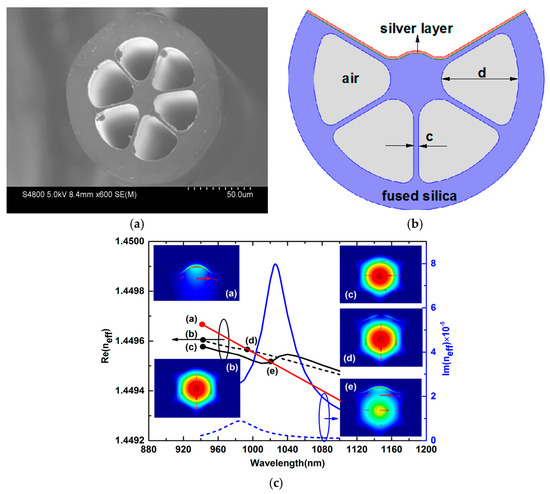
Figure 10.
(a) Cross-sectional image of commercial grapefruit fiber; (b) structural diagram of the designed C-type structure PCF-SPR sensor; (c) dispersion relation and electric field distribution of the core mode and SPP mode [67].
With the increasing depth of research, the influence mechanism of the spatial distribution of metal components on mode coupling has gradually been revealed. Nannan Luan et al. [69] developed a silver wire position–sensitivity mapping model (see Figure 11) to analyze the impact of different silver wire positions on sensing performance. The study showed that the x-polarized mode exhibited higher resolution and required shorter silver wire lengths, giving it an advantage in both wavelength and amplitude detection. This structure inspired Jingwei Lv’s team [70] to incorporate silver nanowires into the symmetric double C-type openings (see Figure 12a), achieving multi-parameter collaborative detection in the mid-infrared band through phase-matching optimization. Compared to traditional metal coatings or single metal nanoparticles, this structure offers higher resonance intensity and narrower spectral bandwidth at the same size, thus providing higher sensitivity and a better signal-to-noise ratio (see Figure 12b). The study indicated that, for refractive indices ranging from 1.47 to 1.52, the sensor’s maximum sensitivity could reach 31,000 nm/RIU, with a resolution of 3.22 × 10−6 RIU (see Figure 12c).
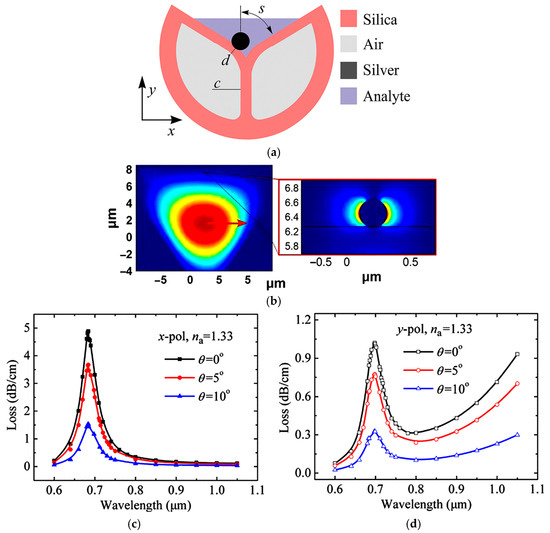
Figure 11.
(a) Structure diagram of an EC-MOF-based SPR sensor; (b) electric field distribution of the X-polarized core mode; (c) loss spectra in the x-polarization direction at different silver wire placement angles; (d) loss spectra in the y-polarization direction at different silver wire placement angles [69].
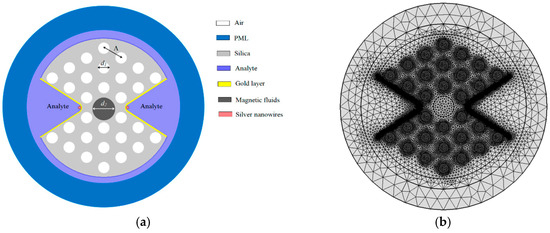
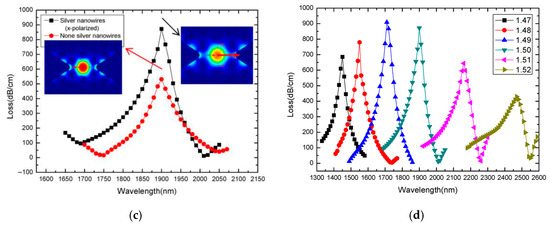
Figure 12.
(a) The 2D structure diagram of the proposed sensor; (b) example of a finite element model with a triangular normal mesh for the calculation region; (c) core loss spectra with and without silver nanowire placement in the x-direction; (d) loss spectra at different analyte RIs [70].
Regarding material innovation, the research focus has gradually shifted from noble metals to functional materials. In recent years, plasmonic materials based on the SPR effect for PCF sensors are no longer limited to precious metals such as gold [69,71] and silver [67]. Therefore, developing novel, low-cost, high-carrier-density surface plasmon materials has become another emerging research direction in optical fiber sensing. Based on this, Jiyu Dong et al. [72] first proposed using molybdenum dioxide (MoO2) as a replacement for traditional gold film materials, achieving an average sensitivity of 4821 nm/RIU in the RI of 1.31 to 1.37, a 335% improvement over traditional gold film (1107 nm/RIU), while reducing material costs by approximately 60%. This breakthrough confirms that transition metal oxides, while maintaining high carrier density, offer advantages in corrosion resistance and high-temperature tolerance, opening new avenues for extreme environment sensing.
Table 4 summarizes the impact of different metal layer optimizations on the performance enhancement of C-type PCF-SPR sensors. The application of metal coatings (references [66,67,68,69,70]) is more straightforward to implement than other complex optical fiber structure adjustment methods. By optimizing the thickness, shape, and surface structure of the metal layer, the optical fiber sensor’s optical properties can be effectively adjusted, thereby enhancing its sensitivity to changes in physical quantities such as temperature, pressure, and strain. Another optimization method is to select different coating materials (reference [72]), as different materials have distinct SPR excitation properties. Properly selecting the coating material can enhance the sensor’s response to changes in the external environment. Future research could further explore the performance of metal composites in extreme environments and, through the combination of multi-metal composites and nanotechnology, drive the application of PCF-SPR sensors in more complex environments, especially in high-temperature, high-pressure, and harsh environments.

Table 4.
Comparison of metal layer optimization results for C-type PCF-SPR sensors.
4.2. Multi-Parameter Performance Analysis of C-Type PCF-SPR Sensors
In the ongoing evolution of optical fiber sensing technology towards multi-parameter, high-sensitivity, and high-integration directions, the C-type PCF has gradually become an important platform to overcome the integration bottlenecks of traditional optical fiber sensors due to its groove-type open structure, mode controllability, and material integration capability. Combined with the SPR mechanism, C-type PCF offers significant optical field enhancement and cavity control freedom, making it particularly suitable for constructing high-performance sensor architectures for the simultaneous detection of multiple physical parameters such as temperature, RI, and salinity (S) [73,74,75]. However, in practical applications, there is often strong cross-coupling and spectral drift between the multi-parameter response signals, which leads to non-unique sensitivity responses and non-linear demodulation paths, severely affecting the system’s stability and accuracy. Therefore, the question of how to achieve effective decoupling of multi-parameter responses and construct a C-type SPR sensing system with high resolution, high selectivity, and high stability has become a key research topic.
Currently, multi-parameter decoupling designs are mainly developed along two paths: the physical dimension decoupling strategy based on spatial channels or polarization modes, and the multi-peak spectral position mapping mechanism based on response spectrum co-regulation. The former emphasizes the structural or polarization orthogonality between channels to achieve independent responses to physical signals. At the same time, the latter identifies parameters in the spectral domain by constructing differential response behaviors of multiple resonance peaks. Both strategies have significantly progressed under the C-type PCF structure and are gradually evolving towards multi-channel and high-throughput integration.
The technological breakthroughs in the multi-parameter detection of optical fiber sensors are centered around the core goal of parameter decoupling, with the development process exhibiting clear phased characteristics. Nannan Luan et al. [76] first proposed the orthogonal dual-channel design scheme (see Figure 13a), laying the foundation for spatial-polarization dual-dimensional decoupling. As shown in Figure 13b, by separating the RI channel (silver layer coating + Y-polarized response) from the temperature sensing channel (thermo-sensitive liquid + X-polarized response), the temperature cross-error was successfully suppressed to below 5%. The optical characteristics of the sensor were analyzed using the finite element method (FEM), and the effects of different RIs and temperatures on sensor performance were studied. The results showed that the Y-polarized resonance peak is highly sensitive to RI changes, while the X-polarized resonance peak is more sensitive to temperature changes. The sensor can independently measure changes in RI and temperature by tracking the displacement of both polarization peaks. This work laid the structural design foundation for subsequent multi-parameter sensing. Zhao et al. [77] broke the symmetry of traditional six-hole optical fibers (see Figure 14a), directionally exciting the X/Y polarization modes to differentiate the responses to salinity and temperature, and effectively decoupling the cross-interference of temperature and salinity using the transfer matrix method. The results showed that the sensor achieved salinity sensitivity of 1.402 nm/‰ and temperature sensitivity of −7.069 nm/°C, demonstrating excellent measurement accuracy and interference resistance. Wu et al. proposed a dual-polarization reflection peak design based on C-type micro-structured fiber gratings (see Figure 14b) [78]. By establishing a pressure–temperature coupling field stress distribution model, PDMS was used to enhance the thermal response, and differential λB,y − λB,x and λB,y + λB,x were constructed as demodulation features, successfully achieving the simultaneous measurement of temperature and water depth. In the 0–10 MPa pressure range, the sensitivities were 1.709 nm/MPa and 1.054 nm/°C, respectively.
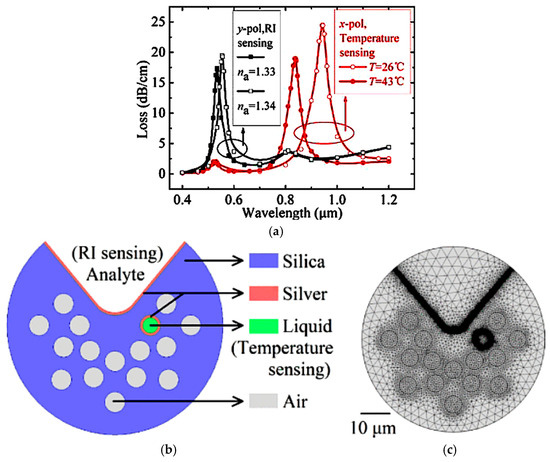
Figure 13.
(a) Polarization loss spectra in the x and y directions; (b) 2D structure diagram of the proposed sensor; (c) example of a finite element model with a triangular normal mesh for the calculation region [76].
Xianxing Ji et al. [79] proposed a dynamic regulation method using thermosensitive materials to enhance cavity control capability. By adjusting the ethanol and chloroform mixing ratio and increasing the openings, they achieved “programmed control” of the thermosensitive liquid response window. This structure increased the temperature sensitivity from 7.6 nm/°C to 19.9 nm/°C, and the quality factor from 82 to 156 (see Figure 15), demonstrating the significant effect of the material response window tuning mechanism on enhanced thermo-optic nonlinearity. In addition to the physical spatial separation strategy, the multi-peak recognition mechanism based on the spectral domain also provides an effective path for multi-parameter collaborative sensing. For example, Xianxing Ji et al. [80] used a side-opening optical fiber structure with gold film coating on the inner and outer surfaces to excite the SPR effect. By coupling the gold film with the core and plasmonic modes of the fiber, they sensed analyte RI and temperature. The study showed that RI changes mainly affected Peak I (sensitivity: 1400 nm/RIU), while temperature changes primarily affected Peak II (temperature sensitivity: 527.2 pm/°C). The low overlap between peaks makes it especially suitable for high-resolution dynamic demodulation environments. Li et al. [81] achieved a compact coupling design by side-etching and depositing a gold film to form a bare fiber structure (see Figure 14c). The inner channel was filled with PDMS for temperature measurement, while the outer channel was in contact with salt solution for salinity measurement, avoiding the signal overlap issues of traditional multi-effect sensors. This design showed good manufacturing simplicity and spectral stability, making it suitable for low-cost engineering integration. In terms of multi-channel extension, Qi-lu Wu et al. [82] achieved technological integration through multi-peak domain decoupling, developing a five-channel C-type PCF sensor (see Figure 16a,b). The five-channel separation technique produced characteristic peaks with spacing greater than 35 nm. Experimental results (see Figure 16c) showed that the sensor could generate five characteristic output peaks under multi-phase immersion conditions, corresponding to different analytes. In the RI of 1.33 to 1.44, the sensitivity ranged from 13,091 nm/RIU to 45,322 nm/RIU, providing five-parameter simultaneous detection capability, marking the shift in single-fiber multi-parameter detection technology from method innovation to system integration.
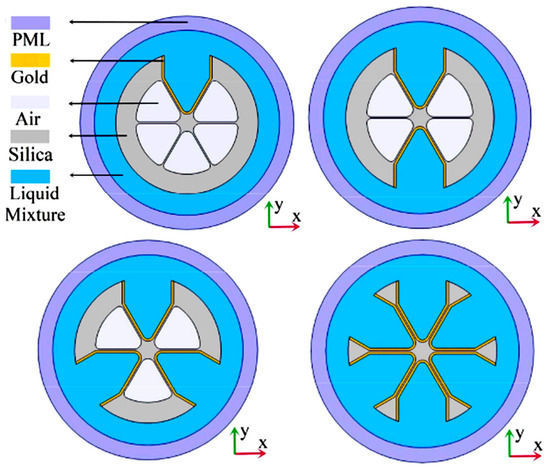
Figure 15.
Cross-sectional view of an SPR temperature sensor based on a grapefruit structure with 1, 2, 3, and 6 holes.
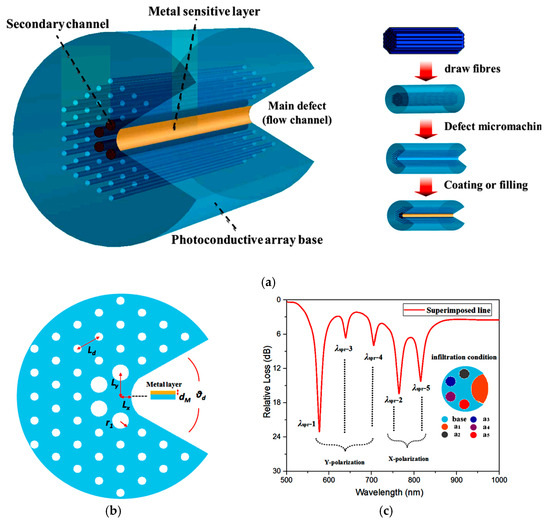
Figure 16.
(a) The 3D diagram of the C-type PCF device; (b) 2D structure diagram of the proposed sensor; (c) multi-phase immersion output spectrum [82].
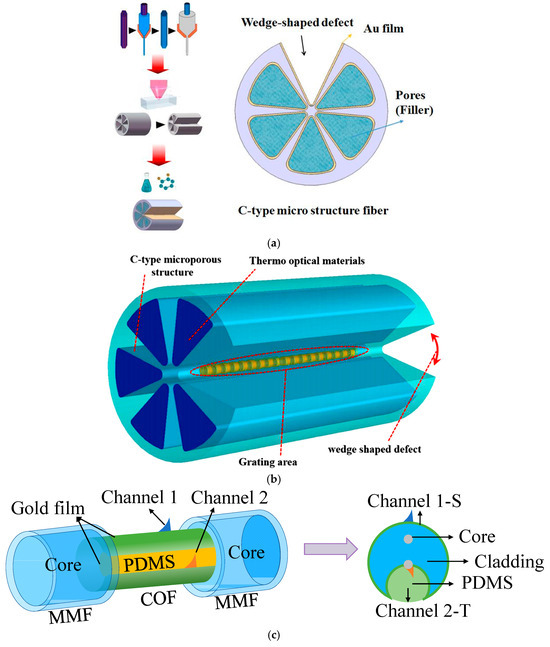
Figure 14.
(a) The 2D structure diagram of the proposed C-type sensor and its fabrication process [77]; (b) design diagram of the C-type micro-structured fiber grating structure [78]; (c) dual-channel SPR sensor probe and structural schematic [81].
Table 5 summarizes the comparative analysis of the multi-parameter performance of the C-type PCF-SPR sensor. C-type PCF SPR multi-parameter sensing technology is transitioning from the “single-structure differentiated response” to a “multi-channel spatial control + multi-peak frequency domain recognition” collaborative design model. The physical decoupling strategy (references [76,77,78]) ensures the demodulation model’s good channel independence and controllability, while the multi-peak spectral design is more suitable for spectral fitting and engineering integration. However, it should still be noted that current designs face engineering challenges regarding micro-nano manufacturing complexity, structural symmetry maintenance, thermosensitive liquid encapsulation stability, and multi-peak recognition algorithm accuracy. Future developments can focus on the following directions: first, exploring response-adaptive intelligent materials (such as liquid crystals and polymer composites) to achieve dynamic response bandwidth tuning; second, integrating AI-driven spectral domain fitting and multi-parameter inversion algorithms to build demodulation systems with low cross-interference and high robustness; and third, combining MEMS and microfluidic integration platforms to develop on-chip, high-throughput multi-channel sensor arrays, improving system portability and edge sensing capabilities. In conclusion, due to its high controllability, channel parallelism, and structural openness, the C-type PCF structure holds significant research value and engineering application potential for future multi-parameter collaborative optical fiber sensing systems.

Table 5.
Comparison of multi-parameter performance based on C-type PCF-SPR sensors.
5. Potential Future Directions
In recent years, C-type optical fiber structures have continued to make breakthroughs in integrated manufacturing precision, micro-scale control capabilities, and multi-parameter fusion mechanisms, driving their gradual transition from laboratory-level performance verification to system-level platform applications. Some studies have explored their engineering usability through exploratory deployment and functional evaluation in quasi-realistic environments, demonstrating good environmental adaptability and integration potential. For example, the all-optical fiber qPCR platform developed by Li et al. [36] uses the C-type optical fiber microcavity structure as a nanoscale biochemical reaction chamber, while integrating temperature monitoring and feedback control functions. The system achieves closed-loop regulation of the thermal cycling process by utilizing interference spectrum changes. The system completed the full PCR process verification, showcasing the engineering feasibility of the C-type structure in portable molecular diagnostic devices in terms of integration configuration and real-time response capabilities. In environmental sensing, the humidity–temperature dual-parameter sensor designed by Zhao et al. [39] combines the UV-curable polymer NOA61 with a C-type optical fiber cavity, achieving high sensitivity for dual-parameter sensing. After several rounds of moisture absorption–desorption cycle testing, its structural stability and response consistency were verified, demonstrating deployment potential in air quality monitoring and industrial environmental control. Furthermore, the multi-channel C-type PCF sensor proposed by Wu et al. [82] achieves multi-peak interference output through structural-level control, enabling multi-parameter synchronous sensing and analysis within a single platform. This “fiber micro-laboratory” platform concept provides new ideas for multifunctional fusion detection in high-throughput, multi-target, and multi-medium environments, especially suitable for on-site deployment and distributed sensing in complex systems.
In summary, these research outcomes, which feature prototype verification and system integration, indicate that C-type optical fiber sensors have gradually completed the critical leap from theoretical modeling to application validation. They have demonstrated good scalability and deployment prospects in several fields, including medical diagnostics, industrial process monitoring, and environmental sensing. Future research should further focus on enhancing the long-term stability of structural encapsulation, the interference suppression ability of signal redundancy, and the performance adaptability evaluation of system-level continuous operation in real-world scenarios. The collaborative advancement of module standardization, demodulation optimization, and system adaptation is expected to drive the large-scale application and commercialization of C-type optical fiber sensors in complex engineering environments.
Although this technology has shown great potential in the field of multi-parameter measurements using C-type optical fiber sensors, there are still some limitations and challenges. Future research should focus on two main directions. The first is research on multi-parameter measurements in conventional structures. When conducting multi-parameter measurements with C-type optical fibers, there may be a trade-off between sensitivity and selectivity, which limits the ability to accurately measure multiple physical quantities in complex environments. While the C-type PCF-SPR sensor has high sensitivity and typically responds to multiple environmental parameters, this can lead to cross-sensitivity issues, making it difficult for the sensor to selectively detect a single parameter. The second direction is improving the sensitivity of C-type optical fibers. Previous studies have shown that optimizing the structural parameters of the C-type optical fiber and the coupling between the core and cladding modes can achieve better performance. Additionally, using metal composites provides a pathway to increase the surface plasmon wave intensity, thereby enhancing the SPR effect. Therefore, optimizing fiber structures and exploring new materials will be another important research direction. Despite these challenges, the ongoing efforts of researchers will drive C-type optical fiber sensors to gradually overcome existing limitations through technological innovation and achieve broader applications in fields such as medical diagnostics, industrial monitoring, and environmental sensing.
6. Conclusions
This paper systematically reviews recent research progress on C-type optical fibers, constructing a comprehensive analytical framework around their structural design, sensing mechanisms, and application scenarios. The paper is divided into five sections: the Introduction begins by discussing the background of optical fiber sensing technology, highlighting the research value of C-type optical fibers in enhancing evanescent field coupling and suppressing temperature cross-sensitivity by comparing the limitations of traditional sensors. The structural design and principles section builds the theoretical framework, explaining the synergistic mechanism of asymmetric cladding geometry control and microfabrication technology, and laying the theoretical foundation for subsequent application research by combining optical field coupling models. The interferometric sensors section analyzes the structural innovation paths of Fabry–Perot, Sagnac, and Mach–Zehnder interferometers, elucidating the contributions of core strategies such as Vernier effect amplification, microfluidic integration, and multimode coupling to performance enhancement. The C-type SPR sensors section focuses on the cross-scale optimization of PCF, systematically demonstrating theoretical and methodological breakthroughs in multi-parameter sensing, from metal heterojunction design to cross-channel decoupling. Finally, the paper outlines the future development prospects of C-type optical fibers, proposing potential technological trends and challenges ahead.
Author Contributions
Conceptualization, Y.Y.; methodology, Z.L.; software, Z.L.; validation, Z.L., Y.Y. and Z.G.; formal analysis, Z.L.; investigation, Z.G.; resources, Z.G.; writing—original draft preparation, Z.L.; writing—review and editing, Z.G.; visualization, Z.G.; supervision, Z.G.; project administration, Z.G.; funding acquisition, Z.G. All authors have read and agreed to the published version of the manuscript.
Funding
This work was supported by the National Natural Science Foundation of China (Grant No. 62273243).
Conflicts of Interest
The authors declare no conflict of interest.
References
- Marques, C.; Leal-Júnior, A.; Kumar, S. Multifunctional integration of optical fibers and nanomaterials for aircraft systems. Materials 2023, 16, 1433. [Google Scholar] [CrossRef] [PubMed]
- Kavitha, B.S.; Pant, S.; Sood, A.K.; Asokan, S. Fiber grating sensors and their recent applications in biomedical domain. J. Opt. 2023, 25, 084001. [Google Scholar]
- Lyu, D.; Huang, Q.; Wu, X.; Nie, Y.; Yang, M. Optical fiber sensors for water and air quality monitoring: A review. Opt. Eng. 2024, 63, 031004. [Google Scholar] [CrossRef]
- Jin, W.; Xu, M.; Zhang, L.; Zhang, X.; Qi, Y. Seawater salinity detection based on elliptical micro/nano fiber optic probe sensing. Opt. Eng. 2021, 60, 127111. [Google Scholar] [CrossRef]
- Al Zain, M.; Karimi-Alavijeh, H.; Moallem, P.; Khorsandi, A.; Ahmadi, K. A high-sensitive fiber specklegram refractive index sensor with microfiber adjustable sensing area. IEEE Sens. J. 2023, 23, 15570–15577. [Google Scholar] [CrossRef]
- Chen, C.H.; Tsao, T.C.; Tang, J.L.; Wu, W.T. A multi-D-shaped optical fiber for refractive index sensing. Sensors 2010, 10, 4794–4804. [Google Scholar] [CrossRef]
- Kassani, S.H.; Khazaeinezhad, R.; Jung, Y.; Kobelke, J.; Oh, K.; Lee, B.; Lee, S.-B.; Rao, Y. In-line chemical sensor based on C-type fiber and novel photonic crystal fibers with high sensitivity and fast dynamic response. In Proceedings of the Fifth Asia-Pacific Optical Sensors Conference, Jeju, Republic of Korea, 20–22 May 2015; Volume 9655, pp. 148–151. [Google Scholar]
- Kassani, S.H.; Park, J.; Park, M.; Oh, K. Sensitivity enhancement of in-line chemical sensing device with C-type fiber and photonic crystal fiber. In Proceedings of the Fiber Lasers IX: Technology, Systems, and Applications, San Francisco, CA, USA, 21–26 January 2012; Volume 8237, pp. 366–373. [Google Scholar]
- Tan, R.X.; Ho, D.; Tse, C.H.; Tan, Y.C.; Yoo, S.W.; Tjin, S.C.; Ibsen, M. Birefringent Bragg grating in C-shaped optical fiber as a temperature-insensitive refractometer. Sensors 2018, 18, 3285. [Google Scholar] [CrossRef]
- Razali, N.M.; Ambran, S.; Zuikafly, S.N.F.; Yuzir, M.A.M.; Sapingi, H.H.J. Design and Simulation of C-Shaped Optical Fiber Sensor. In Proceedings of the 2021 International Conference on Numerical Simulation of Optoelectronic Devices (NUSOD), Turin, Italy, 13–17 September 2021; pp. 109–110. [Google Scholar]
- Razali, N.M.; Ambran, S.; Holmes, C.; Zuikafly, S.N.F.; Lokman, M.Q.; Yuzir, A.; Sapingi, H.H.J. Design optimisation of C-shaped optical fibre sensor. Opt. Quantum Electron. 2022, 54, 421. [Google Scholar] [CrossRef]
- Lin, Z.T.; Zhao, Y.; Zhao, R.; Cai, L.; Hu, X.-G.; Peng, Y. High-sensitivity and low-loss vector magnetic field sensor based on the C-type optical fiber. IEEE Trans. Magn. 2021, 57, 4002308. [Google Scholar] [CrossRef]
- Kuznetsov, P.I.; Sudas, D.P.; Savel’Ev, E.A. Formation of fiber tapers by chemical etching for application in fiber sensors and lasers. Instrum. Exp. Tech. 2020, 63, 516–521. [Google Scholar] [CrossRef]
- Riza, M.A.; Go, Y.I.; Maier, R.R.J.; Harun, S.W.; Anas, S.B.A. Enhanced fiber mounting and etching technique for optimized optical power transmission at critical cladding thickness for fiber-sensing application. Laser Phys. 2021, 31, 126201. [Google Scholar] [CrossRef]
- Tang, J.; Zhou, J.; Guan, J.; Long, S.; Yu, J.; Guan, H.; Lu, H.; Luo, Y.; Zhang, J.; Chen, Z. Fabrication of side-polished single mode-multimode-single mode fiber and its characteristics of refractive index sensing. IEEE J. Sel. Top. Quantum Electron. 2016, 23, 238–245. [Google Scholar] [CrossRef]
- Lei, L.; Li, H.; Shi, J.; Hu, Q.; Zhao, X.; Wu, B.; Wang, M.; Wang, Z. Miniature Fabry-Perot cavity based on fiber Bragg gratings fabricated by Fs laser micromachining technique. Nanomaterials 2021, 11, 2505. [Google Scholar] [CrossRef]
- Fedotov, A.B.; Serebryannikov, E.E.; Zheltikov, A.M.; Sidorov-Biryukov, D.A.; Zhou, P.; Tarasevitch, A.P.; Linde, D.; Hu, M.L.; Li, Y.; Wang, C.Y.; et al. Laser micromachining of microstructure fibers with femtosecond pulses. Laser Phys. 2003, 13, 657–663. [Google Scholar]
- Vasquez, A.; Samolis, P.; Zeng, J.; Sander, M.Y. Micro-structuring, ablation, and defect generation in graphene with femtosecond pulses. OSA Contin. 2019, 2, 2925–2934. [Google Scholar] [CrossRef]
- Mincuzzi, G.; Audouard, E.; Bourtereau, A.; Delaigue, M.; Faucon, M.; Hoenninger, C.; Mishchik, K.; Rebière, A.; Sailer, S.; Seweryn-Schnur, A.; et al. Pulse to pulse control for highly precise and efficient micromachining with femtosecond lasers. Opt. Express 2020, 28, 17209–17218. [Google Scholar] [CrossRef]
- Tatian, B. Fitting refractive-index data with the Sellmeier dispersion formula. Appl. Opt. 1984, 23, 4477–4485. [Google Scholar] [CrossRef]
- Sukhoivanov, I.A.; Guryev, I.V. Photonic Crystals: Physics and Practical Modeling; Springer: Berlin/Heidelberg, Germany, 2009. [Google Scholar]
- Slawinski, M.A.; Slawinski, R.A.; Brown, R.J.; Parkin, J.M. A generalized form of Snell’s law in anisotropic media. Geophysics 2000, 65, 632–637. [Google Scholar] [CrossRef]
- Felsen, L.B. Evanescent waves. J. Opt. Soc. Am. 1976, 66, 751–760. [Google Scholar] [CrossRef]
- Zhao, N.Z.; Williamson, I.A.D.; Zhao, Z.; Boutami, S.; Fan, S. Penetration depth reduction with plasmonic metafilms. ACS Photonics 2019, 6, 2049–2055. [Google Scholar] [CrossRef]
- Miliou, A. In-fiber interferometric-based sensors: Overview and recent advances. Photonics 2021, 8, 265. [Google Scholar] [CrossRef]
- Zhu, C.; Zhuang, Y.; Liu, B.; Huang, J. Review of fiber optic displacement sensors. IEEE Trans. Instrum. Meas. 2022, 71, 7008212. [Google Scholar] [CrossRef]
- Dattner, Y.; Yadid-Pecht, O. Analysis of the effective refractive index of silicon waveguides through the constructive and destructive interference in a Mach–Zehnder interferometer. IEEE Photonics J. 2011, 3, 1123–1132. [Google Scholar] [CrossRef]
- Niciejewski, R.J.; Killeen, T.L.; Turnbull, M. Ground-based Fabry-Perot interferometry of the terrestrial nightglow with a bare charge-coupled device: Remote field site deployment. Opt. Eng. 1994, 33, 457–465. [Google Scholar] [CrossRef]
- Koskinen, V.; Fonsen, J.; Kauppinen, J.; Kauppinen, I. Extremely sensitive trace gas analysis with modern photoacoustic spectroscopy. Vib. Spectrosc. 2006, 42, 239–242. [Google Scholar] [CrossRef]
- Li, J.; Li, Z.; Yang, J.; Zhang, Y.; Ren, C. Microfiber Fabry-Perot interferometer used as a temperature sensor and an optical modulator. Opt. Laser Technol. 2020, 129, 106296. [Google Scholar] [CrossRef]
- Lee, C.L.; Ma, C.T.; Yeh, K.C.; Chen, Y.M. A Dual-Cavity Fiber Fabry–Pérot Interferometer for Simultaneous Measurement of Thermo-Optic and Thermal Expansion Coefficients of a Polymer. Polymers 2022, 14, 4966. [Google Scholar] [CrossRef]
- Cui, Y.; Jiang, Y.; Liu, T.; Hu, J.; Jiang, L. A dual-cavity Fabry–Perot interferometric fiber-optic sensor for the simultaneous measurement of high-temperature and high-gas-pressure. IEEE Access 2020, 8, 80582–80587. [Google Scholar] [CrossRef]
- Ramírez-Hernández, M.Á.; Alonso-Murias, M.; Monzón-Hernández, D. Highly Sensitive Temperature Sensor Based on Vernier Effect Using a Sturdy Double-cavity Fiber Fabry-Perot Interferometer. Polymers 2023, 15, 4567. [Google Scholar] [CrossRef]
- Xie, L.; Nguyen, L.V.; Ebendorff-Heidepriem, H.; Warren-Smith, S.C. Multiplexed optical fiber biochemical sensing using cascaded C-shaped Fabry–Perot interferometers. IEEE Sens. J. 2019, 19, 10425–10431. [Google Scholar] [CrossRef]
- Wu, C.; Liu, Z.; Zhang, A.P.; Guan, B.-O.; Tam, H.-Y. In-line open-cavity Fabry–Pérot interferometer formed by C-shaped fiber fortemperature-insensitive refractive index sensing. Opt. Express 2014, 22, 21757–21766. [Google Scholar] [CrossRef] [PubMed]
- Li, X.; Nguyen, L.V.; Hill, K.; Ebendorff-Heidepriem, H.; Schartner, E.P.; Zhao, Y.; Zhou, X.; Zhang, Y.; Warren-Smith, S.C. All-fiber all-optical quantitative polymerase chain reaction (qPCR). Sens. Actuators B Chem. 2020, 323, 128681. [Google Scholar] [CrossRef] [PubMed]
- Li, X.; Warren-Smith, S.C.; Xie, L.; Ebendorff-Heidepriem, H.; Nguyen, L.V. Temperature-compensated refractive index measurement using a dual Fabry–Perot interferometer based on C-fiber cavity. IEEE Sens. J. 2020, 20, 6408–6413. [Google Scholar] [CrossRef]
- Li, F.; Li, X.G.; Zhou, X.; Zhang, Y.-N.; Lv, R.-Q.; Zhao, Y.; Xie, L.-S.; Nguyen, L.V.; Ebendorff-Heidepriem, H.; Warren-Smith, S.C. Simultaneous measurement of temperature and relative humidity using cascaded C-shaped Fabry-Perot interferometers. J. Light. Technol. 2022, 40, 1209–1215. [Google Scholar] [CrossRef]
- Zhao, K.; Song, B.; Ye, C.; Jin, X.; Yu, C.; Zhou, G.; Pan, J.; Huang, X. Fiber optic relative humidity and temperature sensor with the cascaded Vernier effect based on the C-shaped cavity structure. Opt. Express 2024, 32, 29887–29901. [Google Scholar] [CrossRef]
- Li, F.; Li, X.; Zhou, X.; Gong, P.; Zhang, Y.; Zhao, Y.; Nguyen, L.V.; Ebendorff-Heidepriem, H.; Warren-Smith, S.C. Plug-in label-free optical fiber DNA hybridization sensor based on C-type fiber Vernier effect. Sens. Actuators B Chem. 2022, 354, 131212. [Google Scholar] [CrossRef]
- Qiu, H.; Jiang, J.; Yao, L.; Dai, Z.; Liu, Z.; Qu, H.; Hu, X. Ultrasensitive cascaded in-line Fabry-Perot refractometers based on a C-shaped fiber and the Vernier effect. Opt. Express 2022, 30, 27704–27714. [Google Scholar] [CrossRef]
- Li, C.; Zhao, Y.; Li, Z.; Tong, R.; Chen, M.; Cai, L. Femtosecond laser etching C-type fiber optic vernier sensor for seawater temperature and salinity measurements. Sens. Actuators B Chem. 2024, 416, 135983. [Google Scholar] [CrossRef]
- Sun, L.; Li, J.; Tan, Y.; Shen, X.; Xie, X.; Gao, S.; Guan, B.-O. Miniature highly-birefringent microfiber loop with extremely-high refractive index sensitivity. Opt. Express 2012, 20, 10180–10185. [Google Scholar] [CrossRef]
- Song, Z.; Guo, M.; Wang, Q. A partial discharge detection and localization system for high voltage cable based on long-tailed Sagnac interferometric fiber optic sensor. Microw. Opt. Technol. Lett. 2017, 59, 2132–2136. [Google Scholar] [CrossRef]
- Wu, C.; Tse, M.-L.V.; Liu, Z.; Guan, B.-O.; Lu, C.; Tam, H.-Y. In-line microfluidic refractometer based on C-shaped fiber assisted photonic crystal fiber Sagnac interferometer. Opt. Lett. 2013, 38, 3283–3286. [Google Scholar] [CrossRef] [PubMed]
- Wu, C.; Tse, M.L.V.; Liu, Z.; Guan, B.-O.; Zhang, A.P.; Lu, C.; Tam, H.-Y. In-line microfluidic integration of photonic crystal fibres as a highly sensitive refractometer. Analyst 2014, 139, 5422–5429. [Google Scholar] [CrossRef] [PubMed]
- Li, X.; Nguyen, L.V.; Zhao, Y.; Ebendorff-Heidepriem, H.; Warren-Smith, S.C. High-sensitivity Sagnac-interferometer biosensor based on exposed core microstructured optical fiber. Sens. Actuators B Chem. 2018, 269, 103–109. [Google Scholar] [CrossRef]
- Lin, Z.T.; Zhao, Y.; Lv, R.Q.; Zheng, H.-K.; Zhao, Q. High-sensitivity salinity sensor based on etched C-type micro-structured fiber sensing structure. Sens. Actuators A Phys. 2022, 339, 113518. [Google Scholar] [CrossRef]
- Yu, Q.; Li, X.G.; Zhou, X.; Chen, N.; Wang, S.; Li, F.; Lv, R.-Q.; Nguyen, L.V.; Warren-Smith, S.C.; Zhao, Y. Temperature compensated magnetic field sensor using magnetic fluid filled exposed core microstructure fiber. IEEE Trans. Instrum. Meas. 2022, 71, 7004408. [Google Scholar] [CrossRef]
- Li, Y.; Yuan, W.; Liu, Y.; Yu, C. An ultrasensitive gas pressure sensor based on single-core side-hole fiber with optical vernier effect. J. Light. Technol. 2023, 41, 4509–4515. [Google Scholar] [CrossRef]
- Wang, Q.; Zhang, H.; Yang, M.; Chen, T.; Lin, W.; Duan, S.; Liu, B.; Yang, C. High-sensitivity microfluidic Mach-Zehnder interferometric salinity sensor based on C-type dual-core eccentric-hole fibers. IEEE Sens. J. 2024, 24, 30087–30094. [Google Scholar] [CrossRef]
- Zhang, W.; Gao, W.; Tong, Z.; Zhong, Y.; Xue, L.; Zhang, H. Mach–Zehnder interferometer cascaded with FBG for simultaneous measurement of RI and temperature. Opt. Commun. 2020, 466, 125624. [Google Scholar] [CrossRef]
- Zhao, N.; Lin, Q.; Yao, K.; Zhang, F.; Tian, B.; Chen, F.; Jiang, Z. Simultaneous measurement of temperature and refractive index using high temperature resistant pure quartz grating based on femtosecond laser and HF etching. Materials 2021, 14, 1028. [Google Scholar] [CrossRef]
- Gong, P.; Wang, Y.; Zhou, X.; Wang, S.; Zhang, Y.; Zhao, Y.; Nguyen, L.V.; Ebendorff-Heidepriem, H.; Peng, L.; Warren-Smith, S.C.; et al. In situ temperature-compensated DNA hybridization detection using a dual-channel optical fiber sensor. Anal. Chem. 2021, 93, 10561–10567. [Google Scholar] [CrossRef]
- Li, X.; Nguyen, L.V.; Becker, M.; Ebendorff-Heidepriem, H.; Pham, D.; Warren-Smith, S.C. Simultaneous measurement of temperature and refractive index using an exposed core microstructured optical fiber. IEEE J. Sel. Top. Quantum Electron. 2019, 26, 8678388. [Google Scholar] [CrossRef]
- Li, X.; Nguyen, L.V.; Ebendorff-Heidepriem, H.; Zhang, Y.; Warren-Smith, S.C. Refractive Index and Temperature Sensing with Sagnac-Mach Zehnder Hybrid Fiber Interferometer. In Proceedings of the 2020 Chinese Control and Decision Conference (CCDC), Hefei, China, 22–24 August 2020; pp. 2483–2485. [Google Scholar]
- Cui, J.; Gunawardena, D.S.; Cheng, X.; Htein, L.; Leong, C.Y.; Lau, A.P.T.; Tam, H.-Y. In-line open-cavity Mach-Zehnder interferometric refractive-index sensors based on inter-mode and inter-core-mode interferences. Opt. Lasers Eng. 2024, 172, 107880. [Google Scholar] [CrossRef]
- Qian, Y.; Zhao, Y.; Wu, Q.L.; Yang, Y. Review of salinity measurement technology based on optical fiber sensor. Sens. Actuators B Chem. 2018, 260, 86–105. [Google Scholar] [CrossRef]
- Zhao, Y.; Chen, M.-Q.; Xia, F.; Lv, R.-Q. Small in-fiber Fabry-Perot low-frequency acoustic pressure sensor with PDMS diaphragm embedded in hollow-core fiber. Sens. Actuators A Phys. 2018, 270, 162–169. [Google Scholar] [CrossRef]
- Campanella, C.E.; Malara, P.; Campanella, C.M.; Giove, F.; Dunai, M.; Passaro, V.M.N.; Gagliardi, G. Mode-splitting cloning in birefringent fiber Bragg grating ring resonators. Opt. Lett. 2016, 41, 2672–2675. [Google Scholar] [CrossRef]
- Yang, X.; Zhao, Q.; Qi, X.; Long, Q.; Yu, W.; Yuan, L. In-fiber integrated gas pressure sensor based on a hollow optical fiber with two cores. Sens. Actuators A Phys. 2018, 272, 23–27. [Google Scholar] [CrossRef]
- Nguyen, L.V.; Vasiliev, M.; Alameh, K. Three-wave fiber Fabry–Pérot interferometer for simultaneous measurement of temperature and water salinity of seawater. IEEE Photonics Technol. Lett. 2011, 23, 450–452. [Google Scholar] [CrossRef]
- Kassani, S.H.; Park, J.; Jung, Y.; Kobelke, J.; Oh, K. Fast response in-line gas sensor using C-type fiber and Ge-doped ring defect photonic crystal fiber. Opt. Express 2013, 21, 14074–14083. [Google Scholar] [CrossRef]
- Chao, C.T.C.; Chen, S.H.; Huang, H.J.; Kooh, M.R.R.; Lim, C.M.; Thotagamuge, R.; Mahadi, A.H.; Chau, Y.-F.C. Improving temperature-sensing performance of photonic crystal fiber via external metal-coated trapezoidal-shaped surface. Crystals 2023, 13, 813. [Google Scholar] [CrossRef]
- Abdulrazak, L.F.; Hossain, M.B.; Islam, M.S.; Alkhateeb, A.F.; Mehedi, I.M.; Roy, S.; Hossain, M.S.; Hossain, M.A. Plasmonic sensor based on microstructure PCF: Performance analysis with outside detecting approach. Opt. Quantum Electron. 2022, 54, 58. [Google Scholar] [CrossRef]
- Yang, X.; Lu, Y.; Liu, B.; Yao, J. Simulation of LSPR sensor based on exposed-core grapefruit fiber with a silver nanoshell. J. Light. Technol. 2017, 35, 4728–4733. [Google Scholar] [CrossRef]
- Yang, X.; Lu, Y.; Wang, M.; Yao, J. An exposed-core grapefruit fibers based surface plasmon resonance sensor. Sensors 2015, 15, 17106–17114. [Google Scholar] [CrossRef] [PubMed]
- Yang, X.; Lu, Y.; Wang, M.; Yao, J. SPR sensor based on exposed-core grapefruit fiber with bimetallic structure. IEEE Photonics Technol. Lett. 2015, 28, 649–652. [Google Scholar] [CrossRef]
- Luan, N.; Yao, J. Surface plasmon resonance sensor based on exposed-core microstructured optical fiber placed with a silver wire. IEEE Photonics J. 2015, 8, 4800508. [Google Scholar] [CrossRef]
- Lv, J.; Wang, F.; Hu, C.; Yang, L.; Fu, H.; Zeng, Y.; Chu, P.K.; Liu, C. Numerical analysis of multifunctional biosensor with dual-channel photonic crystal fibers based on localized surface plasmon resonance. Coatings 2022, 12, 742. [Google Scholar] [CrossRef]
- Islam, N.; Arif, M.F.H.; Yousuf, M.A.; Asaduzzaman, S. Highly sensitive open channel based PCF-SPR sensor for analyte refractive index sensing. Results Phys. 2023, 46, 106266. [Google Scholar] [CrossRef]
- Dong, J.; Zhang, S. Characteristics of MoO2 deposited C-shaped photonic crystal fiber sensor with a micro-opening based on surface plasmon resonance. Plasmonics 2023, 18, 1971–1977. [Google Scholar] [CrossRef]
- Liu, L.; Liu, Z.; Zhang, Y.; Liu, S. V-shaped micro-structure optical fiber surface plasmon resonance sensor for the simultaneous measurement of the refractive index and temperature. Opt. Lett. 2019, 44, 5093–5096. [Google Scholar] [CrossRef]
- Luan, N.; Hou, D.; Ji, X.; Zhang, W.; Qi, Y.; Song, L.; Liu, J. Orthogonal-sided polished microstructured optical fiber-based SPR sensor for simultaneous measurement of temperature and refractive index. IEEE Photonics J. 2022, 14, 6824008. [Google Scholar] [CrossRef]
- da Silva, A.A.D.; Oliveira, H.J.B.; Alves, H.P.; Nascimento, J.F.D.; Filho, J.F.M. Computational modeling of magnetic field optical fiber sensor considering temperature effects. J. Microw. Optoelectron. Electromagn. Appl. 2023, 22, 91–100. [Google Scholar] [CrossRef]
- Luan, N.; Ding, C.; Yao, J. A refractive index and temperature sensor based on surface plasmon resonance in an exposed-core microstructured optical fiber. IEEE Photonics J. 2016, 8, 4801608. [Google Scholar] [CrossRef]
- Zhao, Y.; Wu, Q.; Zhang, Y. Theoretical analysis of high-sensitive seawater temperature and salinity measurement based on C-type micro-structured fiber. Sens. Actuators B Chem. 2018, 258, 822–828. [Google Scholar] [CrossRef]
- Wu, Q.-L.; Zhao, Y.; Zhang, Y.-N.; Liu, S.-X.; Zhao, Q.; Chen, S.-Z. Theoretical analysis of seawater depth and temperature measurement with C-type micro-structured fiber grating. Opt. Fiber Technol. 2019, 47, 133–140. [Google Scholar] [CrossRef]
- Ji, X.; Luan, N.; Hou, D.; Zhang, W.; Jiang, X.; Zhang, Z.; Song, L.; Qi, Y.; Liu, J. Sensitivity-tunable temperature SPR sensor based on side-opening grapefruit fiber with liquid mixture. IEEE Photonics J. 2022, 14, 6823908. [Google Scholar] [CrossRef]
- Ji, X.; Luan, N.; Zhang, W.; Qi, Y.; Luo, M.; Liu, J. Side-opening grapefruit fiber-based SPR sensor for simultaneous measurement of refractive index and temperature. IEEE Photonics J. 2022, 14, 6859006. [Google Scholar] [CrossRef]
- Li, L.; Zhang, Y.-N.; Zheng, W.; Lv, R.-Q.; Zhao, Y. Dual-channel in-fiber SPR sensor for simultaneous and highly sensitive measurement of salinity and temperature. Opt. Lett. 2023, 48, 952–955. [Google Scholar] [CrossRef]
- Wu, Q.-L.; Zhao, Y.; Zhang, Y.-N.; Yang, Y. Characteristics of a new multi-channel sensing device based on C-type photonic crystal fibers. Opt. Laser Technol. 2021, 134, 106622. [Google Scholar] [CrossRef]
Disclaimer/Publisher’s Note: The statements, opinions and data contained in all publications are solely those of the individual author(s) and contributor(s) and not of MDPI and/or the editor(s). MDPI and/or the editor(s) disclaim responsibility for any injury to people or property resulting from any ideas, methods, instructions or products referred to in the content. |
© 2025 by the authors. Licensee MDPI, Basel, Switzerland. This article is an open access article distributed under the terms and conditions of the Creative Commons Attribution (CC BY) license (https://creativecommons.org/licenses/by/4.0/).